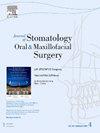A New Approach: Cervical Approach for Marginal Resection of the Posterior Mandible.
IF 1.8
3区 医学
Q2 DENTISTRY, ORAL SURGERY & MEDICINE
Journal of Stomatology Oral and Maxillofacial Surgery
Pub Date : 2024-09-07
DOI:10.1016/j.jormas.2024.102046
引用次数: 0
Abstract
Gingival squamous cell carcinoma (SCC) of the posterior mandible often requires marginal resection of the mandible in conventional surgery. However, the posterior location of the lesion can limit surgical visibility, which is critical for complete tumor removal and minimizing recurrence. Typically, marginal resection of the posterior mandible is achieved through a midline lower lip incision and mental nerve transection, providing adequate exposure but resulting in nerve damage, lip numbness, and facial scarring. In this paper, we describe a case using a submandibular incision for neck dissection, extending from the mandibular angle to the posterior mental foramen, to fully expose the posterior mandible. The intraoral incision, extending 1 cm beyond the tumor margin, connected with the submandibular incision. Under direct vision, we performed a marginal resection of the mandible, preserving the inferior alveolar neurovascular bundle and the mental nerve, and maintaining at least 1 cm of the inferior mandibular margin. This technique achieved complete tumor removal while preserving mental nerve function and lower lip integrity, reducing surgical difficulty and patient trauma. This approach maintains nerve function and aesthetics as much as possible, with a faster postoperative recovery. In treating gingival SCC of the posterior mandible, it is essential to preserve surrounding healthy tissue and critical anatomical structures, minimizing postoperative complications while ensuring complete tumor resection.一种新方法:颈椎入路下颌骨后缘切除术
下颌骨后方的牙龈鳞状细胞癌(SCC)通常需要在传统手术中进行下颌骨边缘切除。然而,病变的后方位置会限制手术的可视性,而可视性对于彻底切除肿瘤和减少复发至关重要。通常情况下,通过下唇中线切口和精神神经横断来实现下颌骨后部的边缘切除,虽然能提供足够的暴露,但会造成神经损伤、唇部麻木和面部瘢痕。在本文中,我们描述了一个使用下颌下切口进行颈部解剖的病例,切口从下颌角延伸至后精神孔,以充分暴露下颌骨后方。口内切口超出肿瘤边缘 1 厘米,与下颌下切口相连。在直视下,我们对下颌骨进行了边缘切除,保留了下牙槽神经血管束和精神神经,并保留了至少1厘米的下颌骨下缘。这种技术既实现了肿瘤的完全切除,又保留了精神神经功能和下唇的完整性,降低了手术难度,减少了对患者的创伤。这种方法尽可能地保持了神经功能和美观,术后恢复更快。在治疗下颌后牙龈 SCC 时,必须保留周围的健康组织和重要的解剖结构,在确保肿瘤完全切除的同时尽量减少术后并发症。
本文章由计算机程序翻译,如有差异,请以英文原文为准。
求助全文
约1分钟内获得全文
求助全文
来源期刊

Journal of Stomatology Oral and Maxillofacial Surgery
Surgery, Dentistry, Oral Surgery and Medicine, Otorhinolaryngology and Facial Plastic Surgery
CiteScore
2.30
自引率
9.10%
发文量
0
审稿时长
23 days
 求助内容:
求助内容: 应助结果提醒方式:
应助结果提醒方式:


